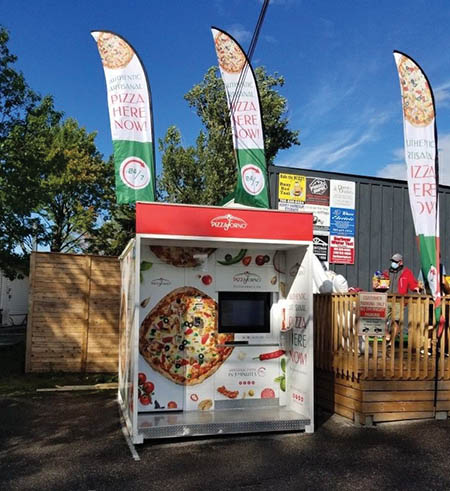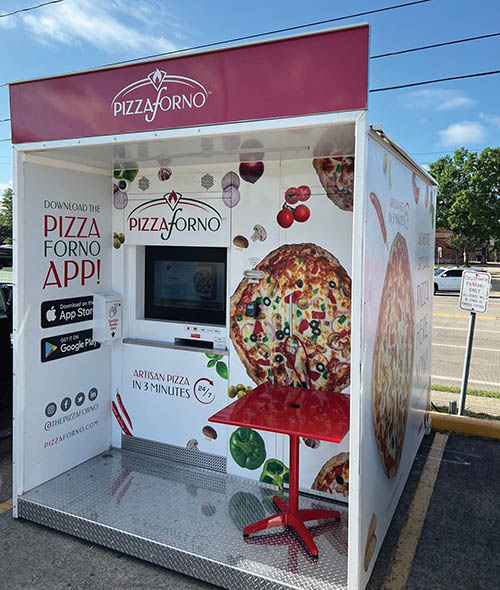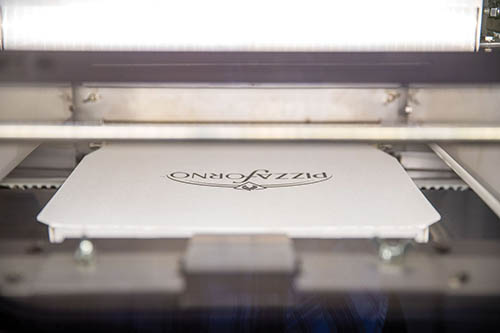— By Les Tomlin —
How automated vending machines are churning out QSR solutions.
Quick-service restaurants (QSRs) are embracing artificial intelligence platforms to boost productivity, increase security and make operations more user-friendly. On paper, things should be getting easier for restaurant owners; however, in the face of rampant labor shortages, skyrocketing minimum wage laws and exorbitant real estate costs, restaurant owners and managers have an uphill battle to face in getting a new business off the ground.

Since the nineteenth century, vending machines have provided an autonomous alternative to full-service restaurants. While their origins lie in the mechanical, vending machines have come a long way to deliver different kinds of pre-packaged goods from gum and canned drinks to fresh, hot pizzas. Vending machines are seen by consumers in North America through a lens of novelty and nostalgia, but these automated devices are a game changer for restaurateurs looking for solutions to labor shortages and the rising costs of running a business.
Working Around Labor Shortages
The U.S. Bureau of Labor Statistics reports that the overall employment of food and beverage serving and related workers is projected to grow 2% from 2022 to 2032. While demand for workers will maintain a steady upward trajectory, the challenges of screening, hiring, training and paying employees are likely to persist. A data brief from the National Restaurant Association shows that 27% of restaurant and foodservice employees are enrolled in school — compared to 10% of employees in the total U.S. employed labor force. As foodservice industry jobs may not always require work experience as a prerequisite for employment, it can be a great opportunity for people to have a steady income while pursuing an education, but it also means that many of those employees will be seeking alternative careers in the near future.
For restaurant owners, this routine turnover can become onerous very quickly. Although new employee training for foodservice jobs tends to be faster than some other industries, it is still a laborious process that requires a sizable investment from hiring managers, operational managers and other team members. Overall, foodservice workers have the lowest median tenure among people working in service occupations at just 1.6 years. While changes to minimum wage laws have made the financial benefits of working in foodservice more appealing to some, restaurant owners are having to adapt their payroll and lessen the number of employees they can hire to stay compliant.
While the challenges of retention and having enough support staff seem like harbingers of tough times ahead, they make a case for harnessing the power of autonomous technology. Machines can replicate menial tasks that might otherwise require a human employee. Intelligent machines have been creeping into various parts of the QSR supply chain, whether that is automating frying fries or automatically flipping burgers. Vending machines can automate the heating and delivery of the food itself. Vending machines can keep track of supply and demand, create a sanitary food storage environment and deliver warm food in a timely manner all hours of the day. Restocking, marketing and business development will be the focus of the human being involved.
Creating a Low-Waste Business Model
Demographics of younger consumers indicate they are drawn toward restaurants taking sustainability seriously. Research by Simon-Kucher & Partners shows that 36% of Millennials and 50% of Gen Z said they were willing to pay a 20% price premium for dining at a green restaurant. For many food and beverage businesses, being sustainable means using environmentally-friendly packaging, using ethically sourced ingredients and limiting the amount of waste produced. A study of 51 restaurants showed that 17.5% of prepared foods were thrown away with much of that being constituted by kitchen waste during preparation. Every restaurant’s shelves and freezers are stocked with food that must be prepared before expiration.

Vending machines, however, get rid of a number of these steps where food is being thrown away. The self-contained nature of automated vending machines being about to heat and serve fresh food eliminates the need for on-site preparation. Additionally, modern vending machines like those used by PizzaForno keep track of expiration dates on food products and time “happy hour sales” to reduce prices on soon-to-be-expired pizzas. In the rare instances when a pizza does exceed its vending date, the product is still consumable for a period of time, so the business owner can remove that item and donate it to a local food kitchen.
Vending machines are an innovative solution to the issues the restaurant industry faces in its goal to become more sustainable. By making use of data collected from packaging about shelf life and strategically offering sales to offload certain inventory, vending machines have created a low-waste business model that prioritizes quality food and quick service over labor-intensive processes with excessive food waste.
Capitalizing on Unconventional Real Estate
Restaurant owners need to be thoughtful when it comes to site selection for a restaurant. Choose an area with not enough traffic, and your business might fail. Choose an area with too much traffic and not enough staff to run the operation, you might find customers getting irritated by slow service, cold food and exhausted staff. There are certain unconventional marketplaces with a unique set of customer preferences that a human-staffed restaurant can’t accommodate, but an automated vending machine could.

Take, for example, a college campus. While mid-morning, there might not be lines of traffic for a pizza, at 1 a.m. on a Saturday night there will be a steady and significant demand for to-go pizza. The value proposition of an all-day vending machine is excellent for restaurant owners who cannot afford to staff a restaurant 24/7. It is compelling for consumers as well as there is no third-party delivery service fee and no need to tip.
The footprint of vending machines is significantly smaller than a full-sized restaurant. The average buildout cost tends to just be the cost of power to run the machine. Securing locations for vending machines can be difficult, as few traditional real estate brokers will feel invested in deals for a few dozen square feet. Parking lots, airports, beach towns and hospitals are great locations where vending machines have a not-so-typical but very consistent consumer base. The flexibility of vending machines does help business owners find innovative alternatives to traditional restaurant locations. There are no sunk costs with real estate with vending machines, because if your original location does not seem like a fit, you can simply call a tow truck and try somewhere else.
Constantly Adapting, Without Being Told
Vending machines can be changed quickly on the back end, giving their owners more control over day-to-day business operations than would be possible with a brick-and-mortar restaurant. Machines can self-regulate in a lot of ways thanks to the incorporation of artificial intelligence to collect data about which kinds of products are more popular at what times of day and how to best position items to attract customers. The algorithms PizzaForno vending machines use are constantly evolving based on purchasing trends. The machine adapts how it presents and prepares food based on the time of day and time of year to maximize its profitability.
As far as food storage and preparation is concerned, vending machines have come a long way. Tunnel freezing and flash freezing make it easy for foods to be safely stored in preparation for a hundred or thousand-mile journey to their final destination. Frozen distribution channels are far more expansive today than ever before, making it easy for frozen foods like pizzas to be safely transported from factories directly to machines. Business owners who make use of centralized production facilities rather than handcrafting food on-site can reduce the cost of production and feel confident that their products are of a high, standardized quality.
At the end of the day, there will always be a craving for sit-down experiences at restaurants and the desire to have human interactions with employees. However, the demand for food delivery alternatives, 24/7 food options and great quality products is on the rise. To accommodate these changing consumer preferences, restaurants need to consider how automation can take their business to the next level. Improved operational systems and faster onboarding are good places to start, but they do not mitigate the hurdles that restaurant owners are sure to encounter in the next few years. Automated vending machines offer tangible solutions to the labor shortage issue while creating an eco-friendly, affordable alternative to traditional QSR dining.
— Les Tomlin is co-founder and president of PizzaForno, North America’s first automated pizzeria that bakes high-quality pizza, 24 hours a day.

